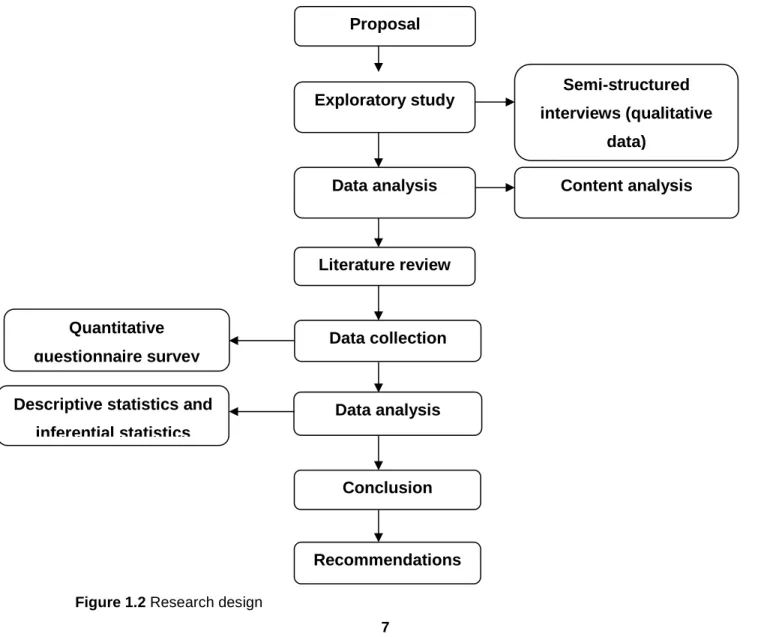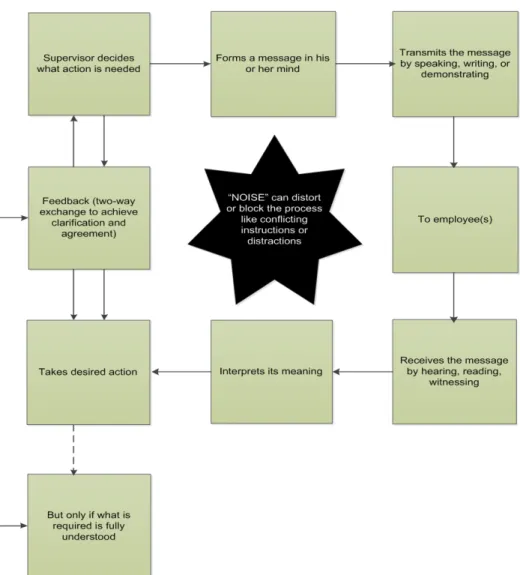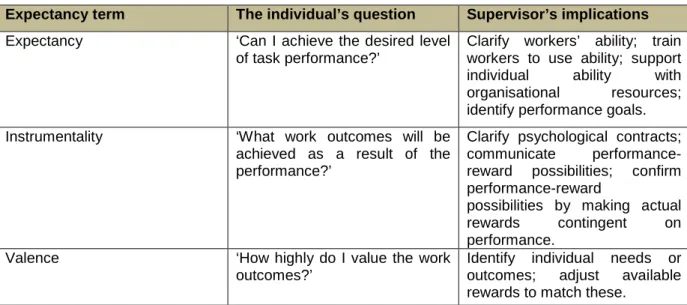LEVEL OF CONSTRUCTION WORKERS ..91 TABLE 5.46 TEST STATISTICS REGARDING EXTRINSIC REWARD TECHNIQUES USED AT LEVEL OF. EMPLOYEES ..85 TABLE 5.51KRUSKAL-WALLIS TEST APPLIED TO INTRINSIC REWARD TECHNIQUES USED ON EMPLOYEE RACES ..86 TABLE 5.52 TEST STATISTICS REGARDING INTRINSIC REWARD TECHNIQUES USED ON RACE OF .
B ACKGROUND TO THE STUDY
Communication
Functional communication is focused on the current task, where the supervisor directs the work, but does not stop because of feedback signals from the worker. Traditionally, supervisors practiced topic-oriented communication and did not focus on the transformational power of communication itself (Hiam, 2003:37).
Rewards
Reinforcement
P ROBLEM STATEMENT
Sub-problems
It is not obvious whether the reward systems used in the field have an impact on productivity according to the demographics of the workers. It is not clear whether the reinforcement techniques used in the field have an impact on productivity according to the demographics of the workers.
H YPOTHESES
A IM
O BJECTIVES
To identify if there is any significant difference in the perception of construction workers regarding reward systems affecting their productivity based on demographics. To identify if there is any significant difference in the perception of construction workers regarding reinforcement techniques affecting their productivity based on demographics.
C ONCEPTUAL FRAMEWORK
S IGNIFICANCE
R ESEARCH DESIGN
The exploratory study, together with the literature review, helped to formulate the questionnaires for the main study. Conclusions were drawn from the results of the exploratory study, literature review and descriptive survey.
L IMITATIONS
An exploratory study was conducted to determine the extent to which motivational supervision strategies can improve the productivity of construction workers.
A SSUMPTIONS
E THICAL STATEMENT
C HAPTER OUTLINE
The chapter discusses the use of supervisory motivation techniques on two construction sites and the effect it has on the productivity of the construction workers. The study identifies supervisory motivational techniques that can contribute to the productivity of construction workers.
I NTRODUCTION
G LOBAL CONSTRUCTION INDUSTRY
Worker motivational programmes
There is pressure on supervisors to abandon their autocratic decision-making style in favor of a more participative, supportive and coaching-like style (Robbins et al. An organizational culture that supports collaboration, commitment to organizational goals and rewards for all workers and management that results from such participation – is an essential basis for success (Robbins et al.
Linking rewards to performance
Germany, France, the Netherlands and the Scandinavian countries have definitively established the principle of industrial democracy in Europe, and other countries, including Japan and Israel, have mostly implemented some form of motivational programs for decades. Whether employee motivation refers to quality circles in Japan, works councils in Germany or Tanzania, or work forums in South Africa, there are common factors that drive success.
Reinforcing behaviour
S OUTH – A FRICAN C ONSTRUCTION INDUSTRY
This trend is supported by the idealization of the American lifestyle by the American television and film industry. Much of South Africa's economically active population is low literate and considered economically illiterate.
O N - SITE SUPERVISION
- Defining construction supervisors
- Levels of supervision
- Construction workers
- Motivating construction workers
- Construction worker performance and motivation
- Levels of construction workers
- Diversity of the workforce
- Age groups within the construction industry
- Education levels of construction workers
- Gender in construction
- Cultures in construction workers
- Subcontractors in the construction industry
In order for motivation to be fruitful and effective in construction, it is important to have an understanding of the construction industry. These unique characteristics of the construction industry are also what make motivating subcontractors more challenging (Mansfield & Odeh, 1991:50).
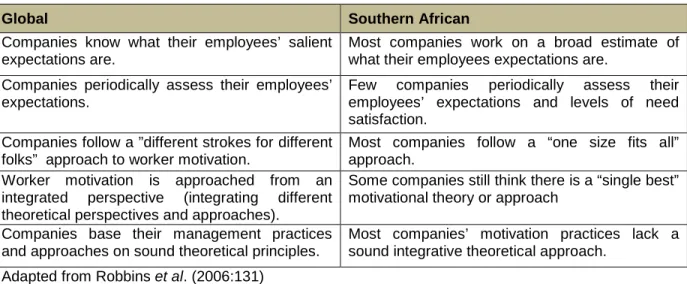
P RODUCTIVITY
Construction productivity
There are ten factors that affect construction productivity: quality; workforce quantity and balance; workforce motivation; continuity of work; complexity of work; the degree of mechanization required; construction method; quality of completed work; the type of contract states that construction productivity is determined by many aspects other than labor including: material; equipment; tools; construction method; and management skills. However, these resources are inactive and useless if they are not transformed into productive tools by the human component and the quality of human performance that mainly depends on motivation (Zakari et al.
The benefits of productivity
The supervisor’s role in productivity
Henderson not only listed the motivators and de-motivators of the construction industry, but also laid out a detailed plan for applying motivational techniques to workers in the construction industry. Supervisors convey the importance of productivity to workers through words and actions (Catt & Miller, 1991:7).
C OMMUNICATION AS A MOTIVATIONAL STRATEGY
- Functions of communication
- Controlling and coordinating group activities
- Motivating organisational behaviour through communication
- Expressing feeling
- Providing Knowledge
- Importance of communication
- Construction supervisor communication methods
- The chain of command system
- Direct contact system
- Group meetings
- Outlining the Communication process
- Message
- Sender
- Receiver
- Decoding
- Channel
- Noise
- Feedback
- Hearing versus listening
- Communicating across cultures
- Goal-setting theory
Decoding is the process by which the receiver translates the message into terms that are meaningful to him. When feedback indicates that a message has not been fully and properly received, the supervisor can attempt to adjust it so that it is better reformed to the receiver.
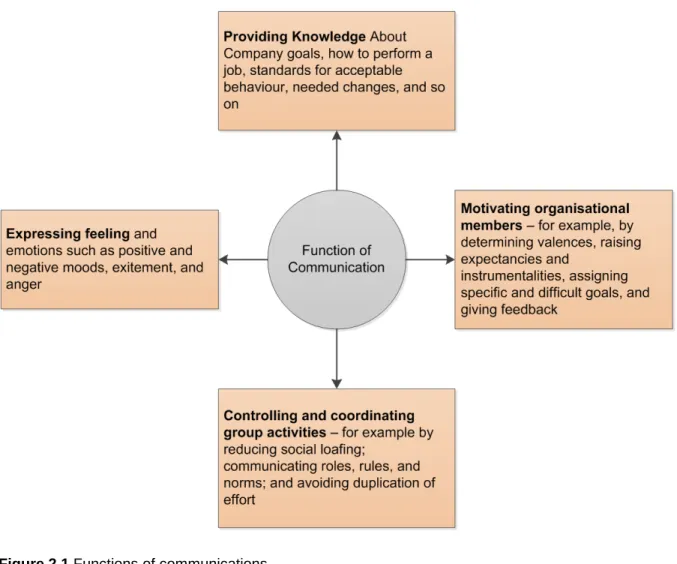
R EWARDS AS A MOTIVATIONAL STRATEGY
- Intrinsic Rewards
- Extrinsic rewards
- Salary as an extrinsic reward
- Day work
- Piecework
- Bonus schemes
- Expectancy theory
- Expectancy
- Instrumentality
- Valence
- Supervisor’s implications of Vroom’s expectancy theory
Currently, one of the most accepted explanations for using rewards to motivate workers is Victor Vroom's expectancy theory (Vroom, 1964:140). It may also be possible to change the individual's perception of the valence of different outcomes (Scemerhorn et al.
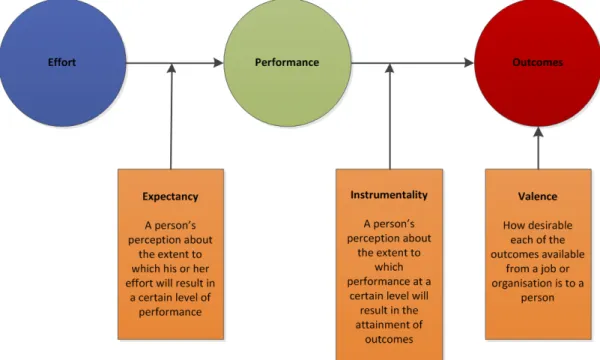
R EINFORCEMENT AS A MOTIVATIONAL STRATEGY
Skinner’s reinforcement theory
- Positive Reinforcement
- Using Shaping as a positive reinforcer
- Reinforcement schedules to acquire desired behaviour
- Negative reinforcement
- Extinction
- Punishment
In general, continuous reinforcement elicits desired behavior more quickly than intermittent reinforcement (Roa). Thus, continuous reinforcement would be important in the initial training of the apprentice casters. Important rewards such as pay raises and promotions must be awarded for achieving employees' specific goals.
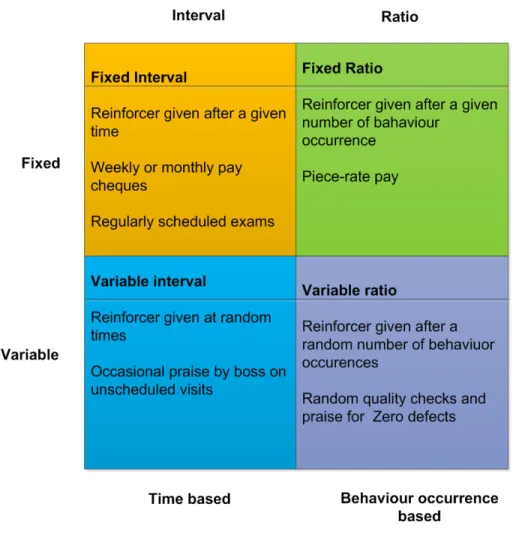
C HAPTER SUMMARY
The literature actually found a difference in the meaning of the word "feedback" as stated in goal setting theory and the word. The literature also reveals the reluctance of construction companies to train their workers.
I NTRODUCTION
M ETHODOLOGY
Epistemology
- Positivism
- Interpretivism
Positivism is connected with quantitative approaches in particular (surveys, experiments, etc.) which emphasize the importance of reliability and generalizability (Denschombe, 2007:57). Therefore, a positivist approach is appropriate, as the research will seek scientific proof of a certain phenomenon.
Ontology
- Objectivism
- Constructionism
Based on the background literature, it is suggested that this study will follow a positivist approach. One of the reasons for using the positivist approach is that the interpretive approach seeks to explain human behavior.
R ESEARCH APPROACH
Deduction
Based on this, it is suggested that the ontological orientation of the present study will be objectivism.
Induction
M ETHODS OF APPROACH
Quantitative
Qualitative
P OPULATION
S AMPLE
Students within the department do their second year Work Integrated Learning (WIL) with construction companies. These respondents were undergoing training in Cape Town as part of the Contractor Development Programme.
E XPLORATORY STUDY
Q UESTIONNAIRE DESIGN
The questionnaire will use mostly closed questions with some open questions. A closed question simultaneously asks a question and gives the respondent fixed answers from which to choose.
R ELIABILITY
It is also preferable for large surveys to have closed questions because they are faster and easier for both researcher and respondent. Likert scales are called summed-rating or additive scales because a person's score on the scale is calculated by summing the number of answers the person gives (Neuman, 2000:251).
V ALIDITY
Scales are common in situations where a researcher wants to measure how an individual feels or thinks about something. d) Instruments: the most accurate instruments were used. e) Exploratory study: an exploratory study was conducted to determine the methods and techniques to be used in the study to ensure accurate and reliable data collection. f) Cronbach's alpha coefficient: Cronbach's alpha coefficient was used to test the reliability of all the scale questions in this study. . g) Purposive sampling approach: the use of a purposive sampling approach technique for the collection of data and the selection of construction workers according to different worker levels and within various trades were the steps taken to ensure validity and reliability of outcome of findings. . h).
M ETHODS OF DATA COLLECTION
D ATA ANALYSIS
Result presentation
The research data must be presented in a meaningful way, so that it provides the necessary information (Dunne et al, 2005: 47). Once the stage of simplifying the study data has been reached, the results should be summarized using one of the following methods to present the study data: tabulation, diagrams and graphs; and frequency distributions (George, 2011:76).
Software to be used
Statistical techniques
- Descriptive Statistics
- Inferential Statistics
When two independent groups are to be compared based on their mean score on a quantitative variable. Maree says this technique is used when there are more than two independent groups that need to be compared on a single quantitative measure or point.
T REATMENT OF HYPOTHESIS
The parametric equivalent of the Kruskal-Wallis test is the one-way analysis of variance (ANOVA) (Wikepedia: online). The statistical techniques to be used in this study are the Kruskal Wallis test and the Mann Whitney U test.
A DDRESSING THE OBJECTIVES
The Kruskal–Wallis rank test (named after William Kruskal and W. Allen Wallis) is a non-parametric method for testing whether samples come from the same distribution. It is used to compare two or more independent samples of the same or different sample sizes.
C HAPTER SUMMARY
I NTRODUCTION
R ESEARCH PARTICIPATION
Types of Communication techniques used on site
- Respect
- Communication
- Feedback
- Listening
- Impact of communication techniques on productivity of construction workers
This is also typical of a supervisor practicing functional communication, where the supervisor does not influence the understanding of the workers (French et al. The follow-up question asked whether these communication techniques used by supervisors improved workers' productivity on the construction site.
R EWARD TECHNIQUES USED
- Salaries
- Bonuses
- Responsibility
- Training
- Impact of reward techniques on productivity of construction workers
Workers have stated that they would like to excel in their various professions but are not receiving the necessary training to equip themselves. Workers felt that they should be rewarded more in order to produce at a higher level.
R EINFORCEMENT
- Verbal affirmation
- Visual signs of approval
- Warnings
- Impact of reinforcement techniques on productivity of construction workers
Some of the workers even said that supervisors would rather fire them than issue a warning. Workers felt In terms of productivity, only 10% of workers felt the need for productivity.
C ONCLUSION AND FURTHER RESEARCH
Regarding the rebar techniques used on the construction site, workers indicated that during the day supervisors rarely or never use rebar techniques. The findings showed that workers need positive reinforcement that will encourage them to be more productive.
I NTRODUCTION
P ILOTING THE QUESTIONNAIRE
R ESEARCH PARTICIPATION
- Gender of respondents
- Age of workers
- Qualification of workers
- Experience of respondents
- Experience of construction workers within the construction industry
- Experience of construction workers working for current contractor or employer
- Worker level of respondents
- Worker level of supervisors
- Trade occupied by respondents
- Achievement of worker productivity
- Meeting expected quantity standards in productivity
- Meeting expected productivity without compromising with time schedule
- Meeting expected productivity without compromising with quality standards
The qualifications of the workers (Table 5.3) are as follows: 4.8% (8) have no formal education, while 9.4% (18) of respondents attended primary school but did not complete it. but did not complete it. 34) of the workers have some form of tertiary certificate or diploma. The table shows that the highest percentage of respondents have worked for less than 5 years in the construction industry.
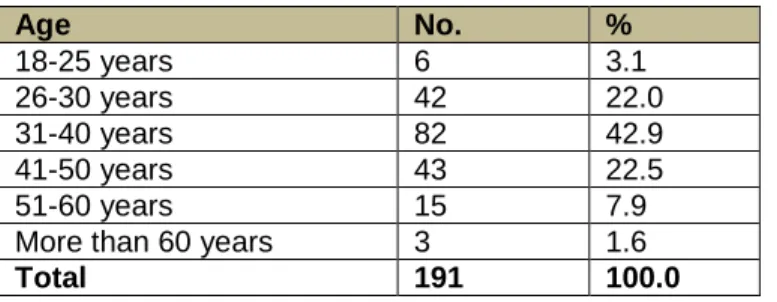
M OTIVATIONAL TECHNIQUES
- Reliability of scaled questions
- The effect of motivational communication on the productivity of workers
- The effect of functional communication on the productivity of workers
- The effect of intrinsic rewards on the productivity of workers
- The effect of extrinsic rewards on the productivity of workers
- The effect of positive reinforcement on the productivity of workers
- The effect of punishment techniques on the productivity of workers
Findings show that respondents somewhat agree that positive reinforcement techniques (mean score 5.30) would motivate workers toward productivity. Findings indicate that respondents somewhat disagree that supervisory punishment techniques (mean mean of 3.20) would motivate workers toward productivity.
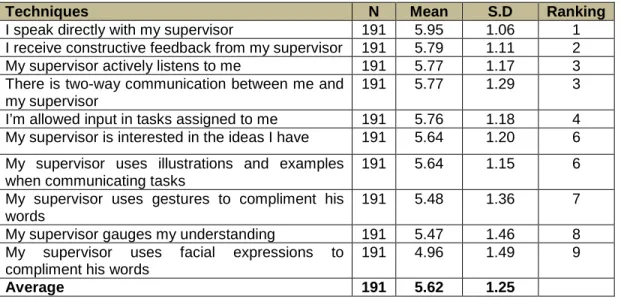
H YPOTHESES TESTING
Hypothesis 1 – demographics on communication techniques
- Test for normality on motivational communication
- Test for normality on functional communication
- Test of significant difference in demographics on motivational communication
- Test of significant difference in demographics on functional communication
In Table 5.25, the median of how workers of the different racial groups perceived the influence of motivational communication is shown. To determine whether the motivational communication results in significant differences between various qualifications of workers, the Kruskal-Wallis test was used (see Tables 5.27 and 5.28).

Hypothesis 2 – demographics on communication techniques
- Test for normality on intrinsic reward techniques
- Test for normality on intrinsic reward techniques
- Test of significant difference in demographics on intrinsic reward techniques
- Test of significant difference in demographics on extrinsic reward techniques
To determine whether the perception of the impact of intrinsic reward techniques on productivity is significantly different between different age groups, the Kruskal-Wallis test was used (see Table 5.45 and 5.46). In Table 5.57, the average of how workers of different racial groups perceived the impact of extrinsic rewards is shown.

Hypothesis 3 – demographics on reinforcement techniques
- Test for normality on positive reinforcement techniques
- Test for normality on punishment techniques
- Test of significant difference in demographics on positive reinforcement techniques
- Test of significant difference in demographics on punishment techniques
To determine whether positive reinforcement techniques make a significant difference between different worker qualifications, we used the Kruskal-Wallis test (see Tables 5.73 and 5.74). Table 5.86 shows test statistics in punishment techniques in qualification groups of workers.

DISCUSSION OF THE FINDINGS
Communication
- Motivational communication
- Functional communication
The supervisory functional communication hypothesis tests on the assignment of employees to increase productivity do not result in statistically significant differences. The results also indicate that perceptions based on gender, age, race and qualification groups did not differ statistically significantly regarding the impact of functional supervisory communication on productivity.
Rewards
- Intrinsic rewards
- Extrinsic rewards
It also appears from the results that the perceptions based on gender, age, race, skill groups and designation were not statistically significantly different regarding the impact of supervisory extrinsic rewards on productivity. The results revealed that the perception based on gender, age, race and skill groups of workers do not affect the impact of supervisory extrinsic reward techniques on productivity.
Reinforcement
- Positive reinforcement
- Punishment techniques
The results showed that employee gender and race perceptions do not influence the impact of supervisory positive reinforcement techniques on productivity. The results showed that employee perceptions based on gender, age, race and qualification groups do not influence the impact of supervisory punishment techniques on productivity.
C HAPTER SUMMARY
Kruskal-Wallis tests were used to determine whether construction worker demographics made a statistically significant difference in supervisors' perceptions of extrinsic reward techniques used for productivity. Mann-Whitney and Kruskal-Wallis tests were used to determine whether construction worker demographics made a statistically significant difference in perceptions of positive supervisor reinforcement techniques used for productivity.
I NTRODUCTION
C ONCLUSIONS
A significant difference is found between the perception of reward techniques used by superiors and workers' demographic data regarding the impact on their productivity. A significant difference is found between the perceptions of reinforcement techniques used by supervisors based on worker demographics regarding the impact on their productivity.
S UMMARY OF CONCLUSIONS
The main study revealed that there is no significant difference between designation, age, gender, race and qualification of construction workers in their perception of reward techniques used on productivity, whether these reward techniques are intrinsic or extrinsic. There is no significant difference in designation, sex, age, race and qualification in their perception of punishment techniques on productivity.
L IMITATIONS
It examines the extent to which reinforcement techniques used by on-site supervisors have an impact on worker productivity. The main study found that there were no significant differences between the designation, gender, and race of construction workers in their perceptions of positive reinforcement techniques used for productivity; however, there are significant differences in workers' age and qualifications in their perception of positive reinforcement.
C ONTRIBUTION TO THE BODY OF KNOWLEDGE
R ECOMMENDATIONS
F URTHER RESEARCH
R EFERENCES
Hierdie opname is slegs vir akademiese doeleindes gedoen deur 'n Meestersgraad in Tegnologie in Konstruksiebestuur-graadstudent in die Departement Konstruksiebestuur en Bourekenkunde aan die Kaapse Skiereiland Universiteit van Tegnologie. Die opname is bloot vir akademiese doeleindes onderneem deur 'n Meestersgraad in Konstruksiebestuur-student in die Departement Konstruksiebestuur en Bourekenkunde aan die Kaapse Skiereiland Universiteit van Tegnologie.

